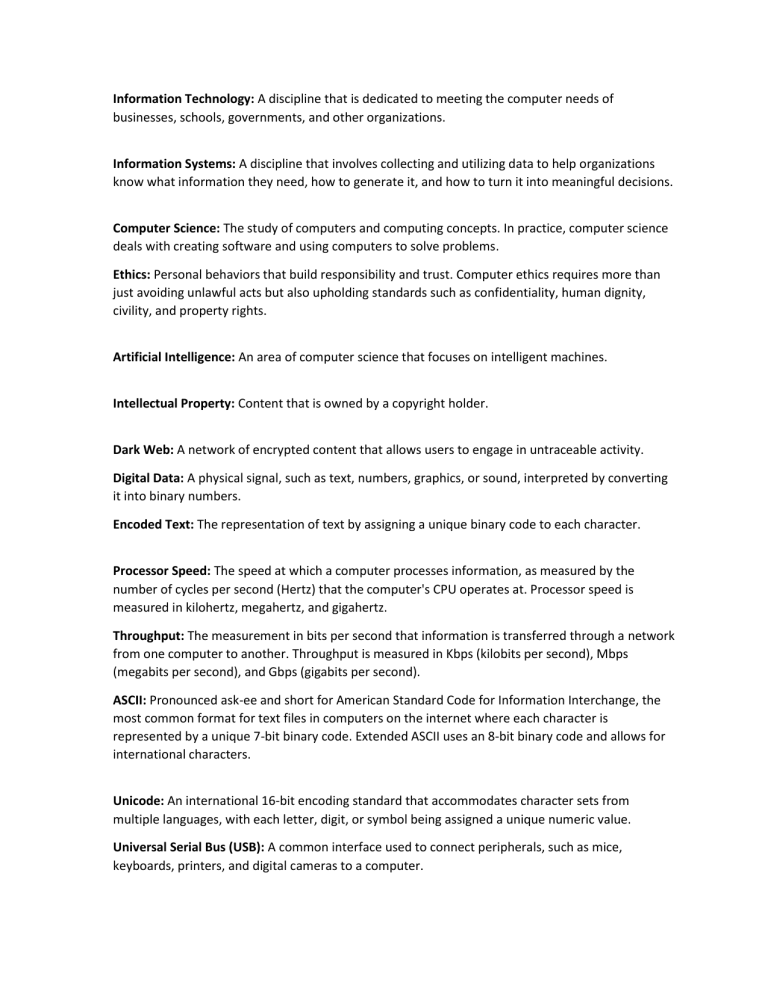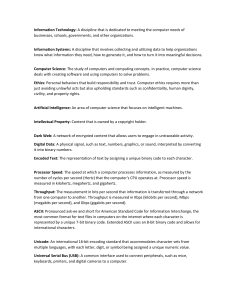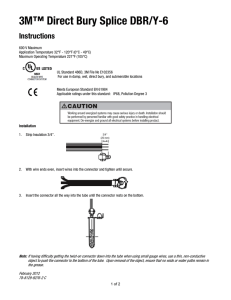
Information Technology: A discipline that is dedicated to meeting the computer needs of businesses, schools, governments, and other organizations. Information Systems: A discipline that involves collecting and utilizing data to help organizations know what information they need, how to generate it, and how to turn it into meaningful decisions. Computer Science: The study of computers and computing concepts. In practice, computer science deals with creating software and using computers to solve problems. Ethics: Personal behaviors that build responsibility and trust. Computer ethics requires more than just avoiding unlawful acts but also upholding standards such as confidentiality, human dignity, civility, and property rights. Artificial Intelligence: An area of computer science that focuses on intelligent machines. Intellectual Property: Content that is owned by a copyright holder. Dark Web: A network of encrypted content that allows users to engage in untraceable activity. Digital Data: A physical signal, such as text, numbers, graphics, or sound, interpreted by converting it into binary numbers. Encoded Text: The representation of text by assigning a unique binary code to each character. Processor Speed: The speed at which a computer processes information, as measured by the number of cycles per second (Hertz) that the computer's CPU operates at. Processor speed is measured in kilohertz, megahertz, and gigahertz. Throughput: The measurement in bits per second that information is transferred through a network from one computer to another. Throughput is measured in Kbps (kilobits per second), Mbps (megabits per second), and Gbps (gigabits per second). ASCII: Pronounced ask-ee and short for American Standard Code for Information Interchange, the most common format for text files in computers on the internet where each character is represented by a unique 7-bit binary code. Extended ASCII uses an 8-bit binary code and allows for international characters. Unicode: An international 16-bit encoding standard that accommodates character sets from multiple languages, with each letter, digit, or symbol being assigned a unique numeric value. Universal Serial Bus (USB): A common interface used to connect peripherals, such as mice, keyboards, printers, and digital cameras to a computer. FireWire: An uncommon interface used to connect peripherals such as digital cameras and external hard drives to a computer. Video Graphics Array (VGA) Connector: A connector, identified by its blue color and three rows of pins, that is used to connect older monitors to a computer. Digital Visual Interface (DVI) Connector: A connector, typically white with three rows of eight pins, designed to connect digital monitors to a computer. High-Definition Multimedia Interface (HDMI) Connector: A connector used to connect a computer to an HDMI monitor or TV. Registered Jack 45 (RJ-45) Connector: A connector used to connect a computer to a wired network. Thunderbolt: An interface primarily used on Apple computers that typically connects a monitor to a computer and can also provide DC power. Troubleshooting: A process that combines knowledge, experience, and intuition to quickly identify the cause of a problem. Power-on Self Test (POST): A test that ensures that all the system's hardware is in working order before loading the operating system. During this test, an error message may display on the screen notifying you of the faulty component. Beep Codes: An audible alarm that occurs when a computer encounters an issue before a power-on self test (POST) has completed when booting. The number and frequency of the beeps can be used to compare information found in the motherboard manual and identify the issue. Operating System: A computer program that makes it so people, hardware, and software can interface with each other in a meaningful way. Graphical User Interface: An operating system interface that allows a user to interact with the computer by displaying pictures, icons, and other images on a screen to represent files, folders, and system controls and by accepting input from a mouse or a touch screen. Command Line Interface: An operating system interface that allows a user to interact with the computer by displaying text on a screen and accepting input from the keyboard. The input is entered as commands. The command line is used primarily by IT and other tech professionals. Windows Update: A feature of the Windows operating system that keeps the system up to date. Windows Registry: A database that stores settings for the operating system and other programs. These settings are stored as keys and values. Registry Editor: A utility of the Windows operating system which lets you view and change all the keys in the registry, giving users greater control over their computers Academic Source: Books or articles written by experts who have credentials in a particular field of study. Consumer-level Source: Resources such as personal websites, online forums, news websites, and online magazines whose audience is consumers of information -- people looking for practical information to solve a problem, make a purchasing decision, or just become better informed on current events and issues. Primary Source: Resources such as original speeches, letters, poems, laws, scientific fieldwork, and artwork. Secondary Source: Resources such as articles or books that review, analyze, or describe primary sources. Tertiary Source: Resources that compile or summarize material from other sources including bibliographies, abstracts, and online article indexes and databases. Citation Style: The format used for citing academic sources, including author, date of publication, and journal title. Plagiarism: The act of taking someone else's work and passing it off as one's own. Default Address Class: A class designation (A through E) that specifies a default subnet mask value which defines the default network address portion of the IP address. Internet Protocol (IP): The principal communications protocol in the internet protocol suite that is used to route information over the internet. Modem: Short for modulator/demodulator, a network device that converts digital signals used by modern networks to analog signals that are typically carried by telephone or cable television lines. Router: A network device that moves traffic between two different IP networks. Switch: A network device that moves traffic within an IP network. Access Point: A network device that connects wireless devices to a wired network. Firewall: A network security device that protects a network by examining the traffic before transferring it to the network. Home Router: A small network device with modem, firewall, routing, and switching features that is used in homes and small businesses.



